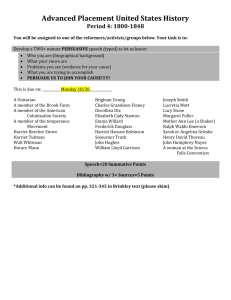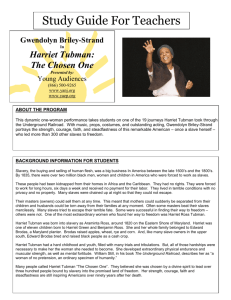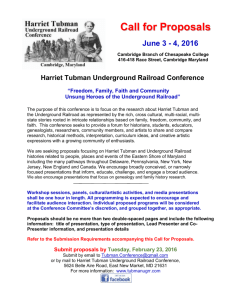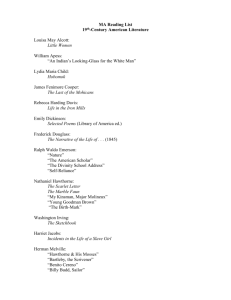Library of Congress Pathways Lesson Module
advertisement
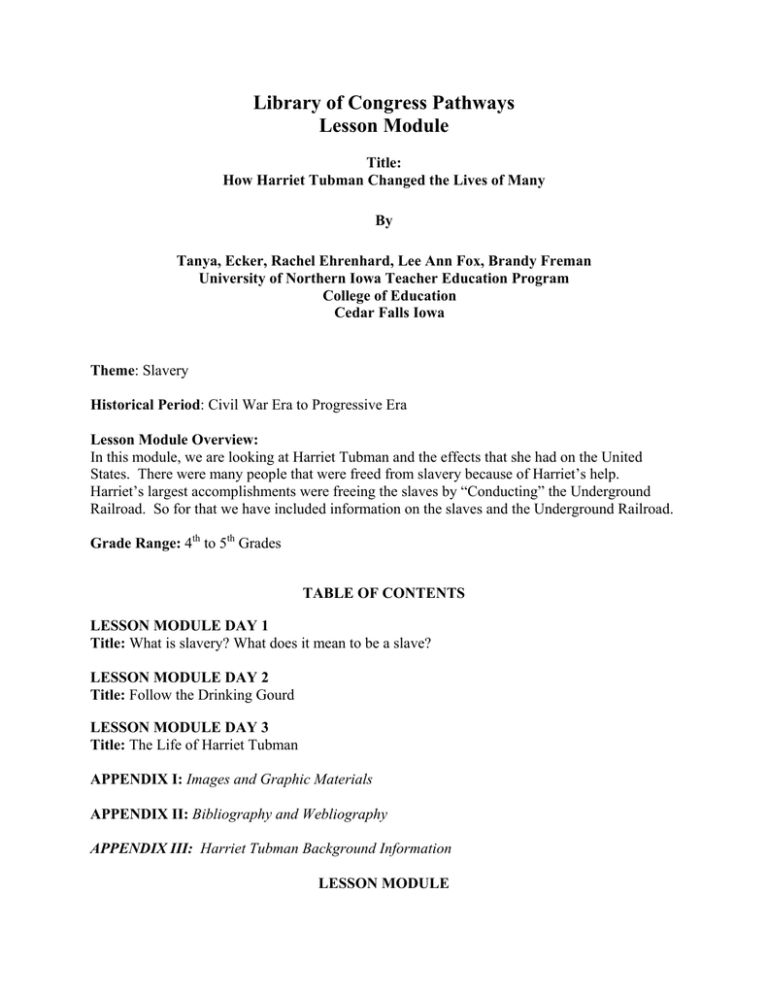
Library of Congress Pathways Lesson Module Title: How Harriet Tubman Changed the Lives of Many By Tanya, Ecker, Rachel Ehrenhard, Lee Ann Fox, Brandy Freman University of Northern Iowa Teacher Education Program College of Education Cedar Falls Iowa Theme: Slavery Historical Period: Civil War Era to Progressive Era Lesson Module Overview: In this module, we are looking at Harriet Tubman and the effects that she had on the United States. There were many people that were freed from slavery because of Harriet’s help. Harriet’s largest accomplishments were freeing the slaves by “Conducting” the Underground Railroad. So for that we have included information on the slaves and the Underground Railroad. Grade Range: 4th to 5th Grades TABLE OF CONTENTS LESSON MODULE DAY 1 Title: What is slavery? What does it mean to be a slave? LESSON MODULE DAY 2 Title: Follow the Drinking Gourd LESSON MODULE DAY 3 Title: The Life of Harriet Tubman APPENDIX I: Images and Graphic Materials APPENDIX II: Bibliography and Webliography APPENDIX III: Harriet Tubman Background Information LESSON MODULE DAY 1 Title: What is slavery? What does it mean to be a slave? Learning Goals: Knowledge -Students will understand the term slavery and what it means to be a slave. -Students will begin to understand the concept of slavery in the past and present. Skills -Students will begin to evaluate information from the internet. -Students will begin exploring sources from the library of congress. Dispositions -Students will begin to look at historical events and correlate them to current events. National Council for the Social Studies Themes: http://www.socialstudies.org/standards/strands Culture: Social studies programs should include experiences that provide for the study of culture and cultural diversity. Time, Continuity, and Change: Social studies programs should include experiences that provide the study of the past and its legacy. People, Places and Environments: Social studies programs should include experiences that provide for the study of people, places and environments. Materials Needed: Chart Paper Markers Dictionary/Online Dictionary with Smart Board Access to computers Resources- see Appendix 1 and 2 Lesson Procedures: Introduction 1. Start out by saying some people are going to have to work on a one page paper today. Students who have a first name longer than their last will take out a pencil and paper and write about a time when they helped someone. The other friends can have a snack and play outside while they wait for the students to finish their work. 2. When the students are all done have them come back together for a small discussion about what they were doing. Ask each group what they thought about their task and then about what they thought of the other group. Ask each group if they think the activities were fair? 3. Add to the discussion that some had to work and some did not. Discuss that in the United States up until1865 there were some people who had to do work and some that did not. Lead the children in to a critical discussion about why they think some people then worked and others did not. Development 1. Write on the board the following inquiry questions: “What is slavery?” “What happened to slavery in the United States?” “Is there still slavery in the world?” 2. So that everyone is clear and on the same page, the teacher will use the smart board to pull up the dictionary definition of slavery. (http://www.merriam-webster.com/dictionary/slavery) Some words in the definition will need to be looked up as well depending on the children’s knowledge. 3. Now that the children have a definition, ask them to tell you what they know. Write their answers on chart paper. Then on another sheet ask them what questions they have about slavery. 4. Post these two sheets on the wall for students to refer back to while they are inquiring during this lesson. 5. Show them the two pictures in appendix 1, “A slave auction at the south” and “Five generations on Smith’s Plantation”. Start a critical discussion about what they see in the photos. Ask how it makes them feel to see the first picture? Ask them if they would want to be born into the five generations of slavery? 6. Read the voices from the days of slavery from Appendix 1. After each one have a critical discussion about what the slaves recalled about that time in their lives. Culmination 1. Have the students, in groups of 4, answer the two questions that were put on the board at the beginning of the development as well as any that they wrote on the chart. 2. They will have to explore the websites listed in Appendix 2 to complete this. 3. Have the student groups write on chart paper what they found out about slavery. Assessment 1. Ask students to write in their journal about how they feel about the information they learned. What surprised them the most when learning about slavery? What do you feel the most important fact you learned was? LESSON MODULE Day 2 Title: Follow the Drinking Gourd Learning Goals: -Knowledge Students will develop an understanding of what the “underground railroad” is and some important people related to it. Students will begin to understand the struggles slaves faced trying to gain their freedom. -Skills Students will be paired together to participate in a scavenger hunt centered on the Underground Railroad. Students will begin exploring various types or primary sources such as maps, images and posters. -Disposition Students will begin to think critically about the struggles faced by slaves searching for their freedom. National Council for Social Studies Themes: http://www.socialstudies.org/standards/strands TIME, CONTINUITY, AND CHANGE: Social studies programs should include experiences that provide for the study of the past and its legacy. PEOPLE, PLACES, AND ENVIRONMENTS: Social studies programs should include experiences that provide for the study of people, places, and environments. POWER, AUTHORITY, AND GOVERNANCE: Social studies programs should include experiences that provide for the study of how people create, interact with, and change structures of power, authority, and governance. Materials Needed: Book Follow the Drinking Gourd by Jeanette Winter Map of the United States for White board Scavenger Hunt Sheets/pencils Reward Poster and Image of Passengers of Underground Railroad Lesson Procedures: Introduction 1. Teacher will begin the lesson by doing a KWL chart on what we have learned about Harriet Tubman’s life. Looking for things “We Know” like: Tubman was a former slave Conductor of Underground Railroad Called the Moses of Her People It was dangerous to help the runaways, and so forth. 2. Next, teacher will talk to the students about “What We Want to Learn” 3. Teacher will turn off the lights in the classroom and have the song “Follow the Drinking Gourd” playing in the background. After the class has listened to the song, teacher will turn the lights back on and ask the class to come to the front of the room to listen as teacher reads them the book. 4. Teacher will read the book Follow the Drinking Gourd by Jeanette Winter. Development 1. Teacher will pause after each verse to discuss with the class what that verse meant. For example that the first verse is talking about starting the journey in the Spring. 2. Next, ask the class what the “old man” is slang for? Looking for answer like it’s nautical slang for a Captain. Then ask who the Captain in this story is. Looking for an answer of Peg Leg Joe. 3. Talk to the students about what marks the slaves were looking for to guide them on the journey. 4. Next talk about the different rivers in the story, the Tombigbee, the Tennessee and the Ohio. 5. The teacher and the class will look at the map on the white board and point out the landmarks and rivers mentioned in the book. They will also talk about the other images they have found from the Library of Congress like the Reward Poster and the image of the passengers on the Underground Railroad. 6. Lastly, ask who the most famous conductor of the Underground Railroad was. This will rely on activating prior knowledge of Harriet Tubman’s life. Culmination 1. Teacher will pair up the students and hand out the Scavenger Hunt Sheets. Teacher will then explain each of the 6 stations set up around the classroom. 2. Student pairs will go from one station to the next and read the question and fill in the correct answer on their Scavenger Hunt Sheets. Students will be able to refer to the answer box on the sheet and the Map on the white board to find the answers. They don’t need to answer the questions in any order, just be sure to answer all of them. 3. Once the Scavenger Hunt is completed the pairs can decode the answers to come up with the extra credit answer at the bottom of the sheet. Extra credit is optional. Assessment 1. Scavenger Hunt sheet will be handed in as the assessment of the lesson. Teacher will also have observed students throughout the reading and discussing of the book, as well as how they worked together on the Scavenger Hunt. Scavenger Hunt Sheet Read the verses and fill in the blanks using terms from Word Bank below. 1. When the Sun comes back, and the first quail calls, Follow the drinking gourd. What season would this be? __ __ __ __ __ __ 2. The old man is waiting for to carry you to freedom. Old man is slang for Captain, who was the Captain in the story? __ __ __ __ __ __ __ __ __ 3. The river bank will make a mighty good road; the dead trees show the way. Left foot, peg foot, traveling on Peg Leg Joe marked the trees and other landmarks with charcoal or mud outlines. The left foot was the outline of a human foot and a __ __ __ __ __ __ __ __ __ was in place of the right foot. 4. The river ends between two hills, there’s another river on the other side. The first river is the Tombigbee, what is the name of the river on the other side? __ __ __ __ __ __ __ __ __ 5. Where the great big river meets the little river, follow the drinking gourd. The great big river is the __ __ __ __ and it comes together with the Tennessee in Paducah, Kentucky. 6. Who was the most famous conductor of the Underground Railroad? __ __ __ __ __ __ __ __ __ __ __ __ __ Extra Credit: Unscramble the highlighted letters to answer this question. What did the drinking gourd symbolize? __ __ __ __ __ __ __ __ __ Word Bank: Molly Harriet Tubman Ohio Lake Erie James Isaiah Spring human foot George Winter round mark Peg Leg Joe old Hattie Summer Tennessee drinking gourd Fall Missouri Answer Key: 1. Spring 2. Peg Leg Joe 3. Round Mark 4. Tennessee 5. Ohio 6. Harriet Tubman Extra Credit: Big Dipper Map of the United States Together as a class, after reading “Follow the Drinking Gourd” we will mark off a route that the slaves might have taken. Start in Mobile, Alabama (Use the Big Dipper) First River is the Tombigbee Go through states of Mississippi and Tennessee Woodall Mountains into Mississippi Tennessee River Ohio River Ends in Paducah, Kentucky LESSON MODULE Day 3 Title: The Life of Harriet Tubman Learning Goals: Knowledge: 1. Students will get to know Harriet Tubman, and why she is/was so important. 2. Students will be able to identify hardships Tubman encountered during her life. Skills: 1. Students will learn what a timeline is, and key information shown on it. 2. Students will learn interviewing skills. Disposition: 1. Students will begin to look at key historical events in Harriet Tubman’s life, and explain why they are significant today. National Council for Social Studies Themes: http://www.socialstudies.org/standards/strands Time, Continuity, and Change: Social studies programs should include experiences that provide for the study of the past and its legacy. People, Places, and Environments: Social studies programs should include experiences that provide for the study of people, places, and environments. Power, Authority, and Governance: Social studies programs should include experiences that provide for the study of how people create, interact with, and change structures of power, authority, and governance. Materials Needed: - white board w/ dry erase marker - Background information about Harriet Tubman - Photos of Harriet Tubman and her life - Paper - Pencil Lesson Procedures: Introduction 1. Begin by showing the students a picture of Harriet Tubman to see if the students can tell me who the picture (found in Appendix IV) is of. If the students do not figure out who it is, then I will tell them. 2. Next, write the following inquiry questions on the white board: Who is Harriet Tubman? What is she famous for? Why is she so important to our history? 3. Write the students’ answers on the board below each question. On the other side of the board write any questions they may have about Harriet Tubman. Have the students write the information on the board, on their own piece of paper, so they can have it right in front of them to refer back to if needed later. Development 1. Distribute to the students a copy of the background information from her life found in Appendix IV. Read this information aloud as a class by calling on students who volunteer to read. List answers to the inquiry questions from the introduction as you come across them while reading. 2. Also while reading, show pictures from Appendix VI and VII to the students when you read about the underground railroad and Harriet’s nickname, “Moses.” 3. When finished with the reading, present students with the following questions: What word would we choose to describe Harriet Tubman as a young girl? As a young woman? As an older woman? Make three big classroom lists, using all the contributions from students. Culmination Students will be assigned to groups of 4 students. Each group will create an imaginary interview with Harriet Tubman. Each group will need to base their questions on the assigned time periods of her life. The time periods will be when she was a little girl, another will be from when she was a young adult, the next will be during the time she was a leader of helping set slaves free, and the last one will be during her older years in life. 1. Each student will research their time periods from Harriet Tubman’s life using information from class discussions, the internet, and information provided by the teacher. 2. Each group then prepares a short interview of the time period of her life they were assigned. 3. Each group must have at least one visual aid for their presentation. 4. Each group will have one person serve as the interviewer, a person as Harriet, a person who will present their visual aid, and a person who will direct and put the presentation all together and give a written copy of the whole thing to the teacher. 5. Each group teaches other classmates about their time period using at least 10 different questions and factual answers during their assigned time period of Harriet’s Life. 6. All students must write down at least three things they learned from each interview. Assessment Using the following resources (story, video notes, history text, and encyclopedia), students will make a time line. Time line dates will begin at Tubman's birth (1820) and end with her death (March 10, 1913). Each student will make their own time line and include at least 10 significant dates during her life. On a separate piece of paper, students will explain why the dates on their timeline are significant. Also the group interviews will be used to assess the knowledge the students’ gained from the lesson and their interviewing skills using the rubric below. Interview : The Life of Harriet Tubman From: http://rubistar.4teachers.org/ Teacher Name: Student Name: ________________________________________ CATEGORY 4 Knowledge Student can accurately Gained answer several questions about the person who was interviewed and can tell how this interview relates to the material being studied in class. Student never Politeness interrupted or hurried the person being interviewed and thanked them for being willing to be interviewed. 3 Student can accurately answer a few questions about the person who was interviewed and can tell how this interview relates to the material being studied in class. Student rarely interrupted or hurried the person being interviewed and thanked them for being willing to be interviewed. 2 Student can accurately answer a few questions about the person who was interviewed. Student rarely interrupted or hurried the person being interviewed, but forgot to thank the person. Before the Before the Preparation Before the interview, the interview, the interview, student prepared student prepared the student several in-depth a couple of in- prepared AND factual depth questions several questions to ask. and several factual factual questions questions to to ask. ask. The student The student Formatting The student edited and edited and edited and & Editing organized the organized the organized transcript in a transcript in a the way that made way that made transcript 1 Student cannot accurately answer questions about the person who was interviewed. Several times, the student interrupted or hurried the person being interviewed AND forgot to thank the person. The student did not prepare any questions before the interview. The student did NOT edit or organize the transcript. Report Writing Sound Quality the information clear and interesting. the information clear. The report is well organized and contains accurate quotations and facts taken from the interview. The report is well organized and contains accurate facts taken from the interview. but the information was not as clear or as interesting as it could have been. The report contains accurate quotations and facts taken from the interview. The report is lacking facts and quotations from the interview OR the quotes and facts are not accurately reported. Both the Both the Both the Very hard to interviewer and interviewer and interviewer hear/understand the person being the person being and the the person interviewed can interviewed can person being be be being interviewed heard/understood heard/understood interviewed and the very clearly. very clearly but are not interviewer. there is some easily times when heard. he/she is hard to hear. APPENDIX I: IMAGES AND GRAPHIC MATERIALS 1. Image This map was published in 1856. It was designed to show the free and slave states. It has images of John C. Freemont and William L. Dayton the 1856 presidential and vice presidential candidates for the newly organized Republican Party. The party’s platform was anti-slavery. 2. Image This is a reward poster for runaway slaves in 1847. This shows just how dangerous it was only to be a runaway slave, but also to help them. At one point the reward offered for Harriet’s capture was $40,000. Yet, she was never captured and never failed to deliver her passengers to safety. 3. Image This image shows slaves using the Underground Railroad. During Harriet’s dangerous journeys she helped rescue members of her own family including her 70 year-old parents. From the Collections of the Library of Congress http://www.loc.gov/rr/print/list/082_slav2.html 4. Image "A slave auction at the south" LC-USZ62-2582 5. Image Five generations on Smith's Plantation..." LC-B8171-152-A Library of Congress – Faces and Voices from the presentation http://memory.loc.gov/ammem/collections/voices/vfssp.html#CharlieSmith.html 6. Image Fountain Hughes, Age 101 "You wasn't no more than a dog to some of them in them days. You wasn't treated as good as they treat dogs now. But still I didn't like to talk about it. Because it makes, makes people feel bad you know. Uh, I, I could say a whole lot I don't like to say. And I won't say a whole lot more." Fountain Hughes, circa 1952. Photograph courtesy of The Jeffersonian newspaper, Towson, Maryland. 7. Image Charlie Smith, Age Uncertain "The highest bidder gets you. He'll carry [you to (?)] his plantation. Put another one up there. Me highest bid, which ever one bid, gives the most, he'll carry him to his plant, that the white, in the South. And they went to mistreating the, the colored. Getting children by the colored women. And all such as that, getting colored. And the white find it out, how they was treating them. They hurt them. And they come down here, the first war ever was in the United State was the North and South fought a war to free the colored." Charlie Smith, 1976. Photograph by Peggy Kehoe, courtesy of The Polk County Democrat, Bartow, Florida. 8. Story 9. Image Picture of Harriet Tubman http://www.americaslibrary.gov/aa/tubman/aa_tubman_subj.html 10. “Moses” Picture http://www.americaslibrary.gov/aa/tubman/aa_tubman_subj.html APPENDIX II: BIBLIOGRAPHY AND WEBLIGRAPHY OF RESOURCES FOR STUDENTS AND TEACHERS Bibliography of Children’s Literature: Winter, J. (1988) Follow the Drinking Gourd. New York: Dragonfly Books Webligraphy of Supporting Online Resources for Student Library of Congress: Tubman: Conductor of the Underground Railroad This is a collection of readings from the Rare Book and Special Collections Reading Room about Harriet Tubman’s journey to freedom and her efforts to help other slaves gain their freedom. http://memory.loc.gov/ammem/browse/ListAll.php Library of Congress – Faces and Voices from the presentation http://memory.loc.gov/ammem/collections/voices/vfssp.html#CharlieSmith.html National Underground Railroad Freedom Center, People of the Underground Railroad This is a student friendly website with good information on Harriet Tubman and the Underground Railroad. http://www.freedomcenter.org/underground-railroad/freedom-stations/scholarship/people/ Social Studies for Kids – Slavery in America http://www.socialstudiesforkids.com/subjects/slavery.htm Appendix III Background Information From: http://teacherlink.ed.usu.edu/tlresources/units/byrnes-famous/tubman.html#background A woman with tremendous courage, strong as a man, and cunning as a fox was Harriet Tubman. She was unable to read or write and yet Harriet made 19 journeys back to the Southern States to help free over 300 slaves, moving them to the Northern States and Canada. Harriet chose a dangerous way of life. Working with the Underground Railroad gave her popularity that angered slave owners but gave inspiration to slaves. During this time, the United States was close to war over the issue of slavery and Harriet was ready to help the Northern States in any way she could. Her vision was to give freedom to every black slave. Araminta Harriet Ross was born a slave in Dorchester County, Maryland in 1820 or 1821. The exact date is not known. She was the child of Benjamin Ross, and her mother, Harriet Greene. Her master's name at the time was Edward Brodas. Throughout her childhood, she was known as Harriet. Being born into slavery meant that you were property and had no rights. Even as children, slaves were expected to work long hours. Many slaves worked all day and long into the night. They were expected to work hard and fast and to be obedient to their masters. Some slave owners took good care of their slaves. However, some masters were not very kind and liked to make an example out of slaves that misbehaved or tried to run away. They were often beaten or whipped. As a child, Harriet was often hired out to work for other slave masters oftentimes doing housework. As she grew older, she was sent to work in the fields with other slaves. These people worked in fields that produced many kinds of crops including corn, potatoes, tobacco, and cotton. Harriet was a small girl but grew to be strong physically and strong willed. When she had a goal in mind, Harriet was determined to carry it out. Seeing how she and other slaves were so commonly mistreated, angered her. She wondered if anyone could help them gain there freedom. The Bible story of Moses leading the children of Israel out of Egypt meant a lot to Harriet. The people of Israel were slaves like her people. One experience that greatly affected her life took place when she was trying to help another slave. Harriet's overseer was angry at the slave and when he went after the slave, Harriet blocked the doorway to stop him. The overseer took an iron weight and threw it at Harriet striking her in the head. She was near death for some time and had a deep cut on her forehead for nearly eight years. For the rest of her life, Harriet suffered severe headaches and sleeping spells. In 1844, Harriet married John Tubman, who was a free man. They lived close to the Brodas plantation in John's cabin. Harriet frequently talked about freedom but John was content with what he had. He thought escaping was too risky when they already had a nice living. It was said that Harriet was unhappy in marriage. She grew impatient with her husband since they did not share the same dream of freedom. One night, without telling anyone, she decided to escape from the plantation in the summer of 1849. Harriet found help and shelter in the home of a Quaker woman. The Quakers were opposed to slavery and had connections with the Underground Railroad. Different safe houses were a part of this secret system that aided slaves in their attempt to reach the North. Free blacks and sympathetic whites would help runaway slaves find food, shelter, transportation, and guide them on their trek. Much of Harriet's journey was during the night when it was easier to hide from slave hunters trying to recapture any escaped slaves. The North Star was her guide in the night that gave her hope and pointed her in the direction of freedom. Finally, Harriet crossed the state line of Pennsylvania. She was a free woman. In overwhelming joy she said, "I looked at my hands to see if I was the same person now I was free. There was such a glory over everything. The sun came like gold through the trees and over the fields, and I felt like I was in heaven (Sterling, page 43, 1954)." When Harriet arrived in Philadelphia, she began to work. Her hopes were to earn enough money to help get Harriet's family to freedom in the North. Soon Harriet Tubman joined William Still, an abolitionist, who was connected with the Underground Railroad. Mr. Still was instrumental in organizing the connections and financing of the railroad. Harriet soon joined the abolitionists and became a conductor for the railroad. Between 1850 and 1860, she saved money to make 19 trips to the South to free about 300 slaves. As stories of her bravery grew, she soon became known as "Moses," after the Biblical Moses who led the slaves out of Egypt. Though she was a hero to slaves, her popularity endangered her. After years of eluding slave hunters, white slave owners posted a reward of $40,000 for her capture. With the help of her allies and well planned routes, Tubman was never captured and the reward was never collected. When the Civil War broke out between the North and the South in 1861, Tubman served with the Union army of the North. She shared the dream that President Abraham Lincoln had in bringing freedom to the slaves in the South. Harriet worked as a nurse, scout, and a spy for the Union and in 1863, she led a group of black soldiers under Colonel James Montgomery on a raid. Nearly 800 slaves were freed as a result. After the war, Harriet Tubman returned to her home in Auburn, New York. Since her husband John Tubman died in 1867, she married a former slave and Union soldier, Nelson Davis in 1869. After his death in 1888, Tubman continued to help the sick, poor, and homeless blacks and support their efforts for black voting rights. A $20 per month pension from the United States Government was eventually given to Harriet for her service in the Civil War. She used the money to support these causes. Harriet Tubman died on March 10, 1913. She will always be remembered for her courage, bravery, kindness, and love. Harriet Tubman was one person who began to help change peoples views of slavery and freedom. She would be proud of the steps that have been taken to remind humankind that we were all created equally.
